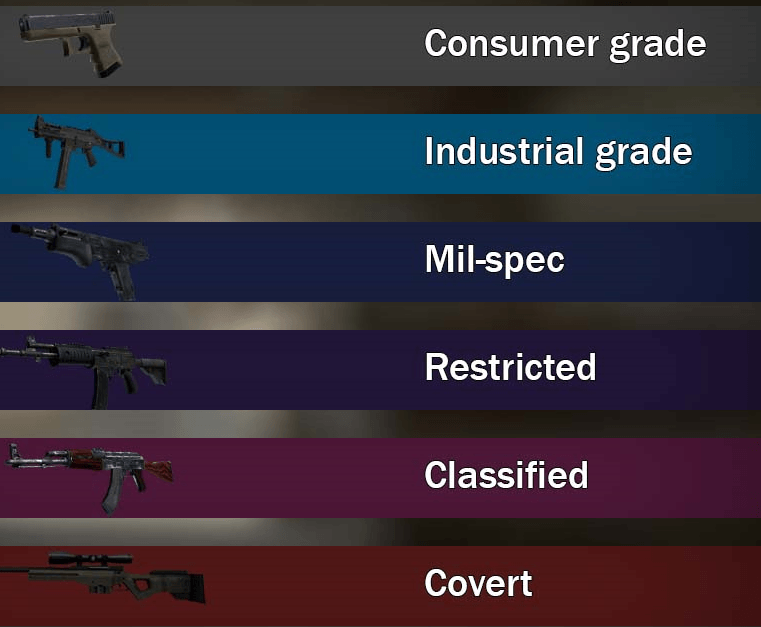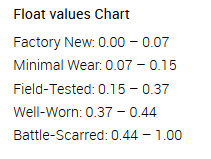A Beginner's Guide to CSGO Skins
CSGO skins can be an amazing part of the game if you have the right knowledge on them.
CSGO skins can be an amazing part of the game if you have the right knowledge on them.
Counter Strike: Global Offensive is a very complex game with many different game modes and features within it. But one big part of the game isn't even a game mode, it's the "skins". Weapon skins are colorful designs and patterns that you put on your guns, gloves, and knives. If you ever played Call of Duty, they are similar to "camos". But the world of CSGO, skins are much bigger than that. It became a huge network of traders and many different markets. There are hundreds of amazing skins to choose from, but you can't dive in without the basic knowledge of how they work.
Unlike Call of Duty, you don't obtain skins buy leveling up your gun or getting them from a DLC. In CSGO, the main of way of getting them is buying, trading, or opening them since they are actually worth real money on a changing market. Every now and then you can get a skin from in-game drops at the end of a match, but those are lower quality ones worth 3-4 cents. It is very rare for someone to get an expensive skin from an in-game drop. You can purchase skins using the Steam Community Market (not the main store for games) under Counter Strike: Global Offensive. The market has its own tab on Steam which you should see right away. Skins vary in price, so make sure to pick one you like in your budget range. If you ever want to get rid of your skin and get money back from it on Steam, you can sell it on the market too. Valve (Steam's owners/creators) will take a cut of the money though, you will be told how much you get to keep when selling it.
If you are a gambler and like taking risks, you can buy weapon cases. Weapon cases are yellow or black containers that give you a random item from a collection of weapon skins. You must buy a $2.50 key from the same case in-game to open the one you chose. Currently there are 31 cases in the game; the prices vary but they are common to get at the end of a match. There is a small chance for making a profit when opening cases. If the skin you got is worth more than the price you paid for your case and key, then you made a profit. If you could have bought the skin for cheaper on the Steam Community Market, than you lost money. After seven days, the weapon skin will be tradeable, and you can exchange them with other players. But you can sell your skin on the market at any time.

There are six different rarities of skins for your gun. Just to clarify, the guns in the picture above have nothing to do with the rarities; you can get a skin at any rarity with any gun. Consumer grade (grey) is the most common drops, while Covert (red) skins are the most rare and expensive to get. Consumer and Industrial grade skins are not in weapon cases, only Mil-spec (blue), Restricted (purple), Classified (pink) and Covert (red) are enclosed. If you are really lucky you can get a yellow, which gives you knives or gloves. If you got a yellow, you hit the CSGO jackpot. They are rarer and more expensive than most gun skins, even red.
All skins start in weapon cases, which people open and then choose to keep or sell on the market to people who want a specific skin. Usually Classified, Covert, and sometimes Restricted give you profit when opening cases, but every now and then a Mil-spec or industrial grade skin could be worth a lot of money. Some skins might not drop a lot in cases or matches, causing the price to go up since they are harder to get. Two other ways your skins may be worth more is if they are StatTrak'd or a part of a souvenir collection. StatTrak skins keep track of your kills with that gun, while souvenir guns are dropped when watching tournament matches in-game. Souvenir skins have golden stickers from their origin match on them.

Not all skins in the game look the cleanest, there are five different types of wears for each skin. Factory New wears look the cleanest with the least scratches, while skins with the Battle-Scarred wear are the most torn up with a lot of scratches. When you hover over a skin in your inventory it should tell you the wear of it. The float of a skin is how much it is worn down. The picture above shows how much a skin can be worn down in each category. The higher the float number the more beat up the skin is. To the find the float of your skin, you right click it in your inventory and hit the "inspect" button. After that there should be a little "i" for more information in the bottom left, then you should be able to see the float number.
The wear/float process when on the Steam Community Market is different but still simple. When looking at a skin on the market, you should see the wear right after the name. Each wear has its own market page for each skin, so you should see 5 different market pages for the same skin. A few skins don't have all five wears so don't be surprised if you can't find their listings. The wear is listed right next to the skin name on the market. If you want to inspect the skin and find its float, there should be a small arrow in the bottom left of the marketing listing, click that and hit "inspect." Back in the game, you should see the market item.
Do you remember putting stickers on everything when you were little? Because Valve didn't forget. You can take any skin and apply 4 stickers of your choice to it. You can search the market under CSGO for many different stickers from all sorts of categories. For all the Halo fans, Valve released a line of Halo stickers for a fair price. Stickers also have their own case you can open too, but they are called "Capsules" instead. Stickers can have animals, monsters, old-school pinups, you name it. Valve also has your favorite esports team with their own line of stickers. If you are in a really creative mood, $2.15 can get you a name tag, which allows you to name your gun anything with a limit of 20 characters. So don't be afraid to buy a plain looking skin, because the customization possibilities are endless.
Some people have a different form of "fun" and like scamming other people. Over the years scammers have been very creative and keep finding new ways to lure new players in, or even hack accounts. Valve has trouble tracking every individual down, so you have to be on the lookout. If someone offers you a deal that's too good to be true, that's because it probably is. Don't click their link to some unknown case opening site and sign in, because you could get your account hacked. Some other common scams are:
- People claiming their item is super rare and giving you a discount on it
- Scammers stating that if you give them your skin, they can copy it for you and give you back double
- They are willing to overpay by a lot, but they need you to give it to them first so they can "properly" inspect it
- Scammers may claim Valve sent workers to your profile because your skins might be "fake," so you must give them to these people so they check them or they will ban your account
If you get a random invite from someone you don't remember playing with, they are most likely after your skins, so proceed with caution. When I had a wealthy inventory, I was receiving countless invites from strangers who were advertising fake trading websites and reported countless scammers. When I sold most of my skins, I stopped getting random invites. Now that I started rebuying skins, the invites came flooding back to my inbox. You can always hit the report button of course, but even after getting trade banned, these people can always come back on new accounts, so always be on the lookout.
Now that you know the basics of CSGO skins, picking out what you want should be a much easier process. But it is a very complex trading world, so never stop doing research. More articles will be added about unique patterns and other great things, so stay tuned and stay sharp.